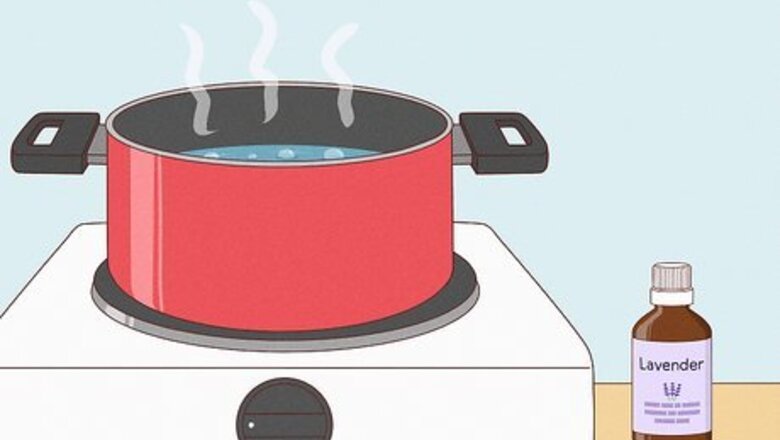
views
Deep Cleaning with Steam

Heat and mix your water. Hot steam opens your pores and gets your skin ready for acne treatment. Fill a 1 US qt (0.95 L) pot with water and bring it to boil for one minute. Add one to two drops of essential oil for every of 1 US qt (0.95 L) of water. Boil the water for another minute after adding one of the following essential oils: Spearmint or peppermint: these contain menthol, an antiseptic that can improve your immune system. Since some people find mint irritating, start by using one drop for every quart of water. Calendula: this plant accelerates healing and has antimicrobial properties. Lavender: this herb is soothing, calming, and can help with anxiety and depression. It also has antibacterial properties. Using essential oils can help your body quickly reabsorb blind pimples or draw them out so they heal faster. Some essential oils can even prevent pimples. Test the oil on your skin before steaming your face. Put a single drop of the essential oil on your wrist and wait 10 to 15 minutes to see if you have a sensitivity. If your skin reacts (becomes itchy or red), don’t use the oil.
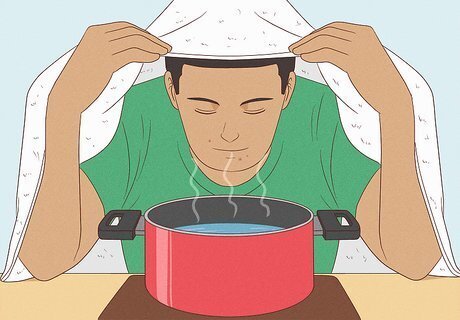
Steam your face. Turn off the stove and take off the pot. Cover the back of your head with a large towel, then bend over the steaming pot so that the towel falls around the sides of your face and traps the steam. Close your eyes, breathe normally and relax for 10 minutes. Rinse your skin with lukewarm water and pat it dry. Keep your face at least 12 to 15 inches (30.5 to 38.1 cm) away from the water so you don't burn yourself. Steaming opens up your pores to clean out deep debris and facial oil. If you want to do more than one facial in a day, just reheat the water till it starts to steam.

Apply a moisturizer. Seal in the hydration from the steam facial by applying a non-comedogenic moisturizer. Moisturizing also helps prevent damage to your skin while keeping it soft and flexible. If your skin is sensitive to products you use, look for a moisturizer that doesn't contain fragrance or perfume. The simpler the product (fewer ingredients), the better.
Over-the-Counter Acne Medication

Bring blind pimples to the surface with salicylic acid. Salicylic acid fights and prevents acne by breaking through layers of skin and releasing trapped dirt. Use a salicylic acne wash or acne patch to get blind pimples to come to a head. While you should never try to pop a blind pimple, you can pop one that has opened at the surface.

Try a hydrocolloid patch. Hydrocolloid patches have been used since the 19th century to draw contaminants up and out of the skin. Put one over your blind pimple and leave it for the duration suggested in the product's instructions. Patches also help keep you from picking at your skin while it heals.
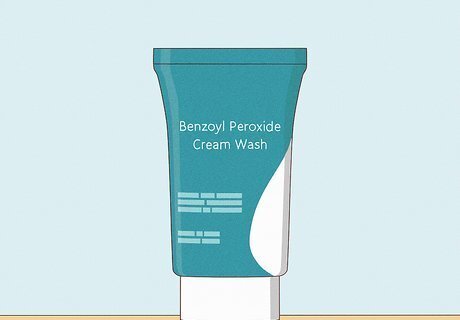
Treat blind pimples with benzoyl peroxide. Benzoyl peroxide is another acne fighting medication that dermatologists love. Rub a cream wash into your skin, then rinse it off. Benzoyl peroxide kills the bacteria around it, but may also bleach your skin.
Cleansing Your Face

Choose a gentle cleanser. Look for a gentle, non-abrasive, plant-oil based cleanser that's labeled as "non-comedogenic." This means the cleanser won't clog your pores, a major cause of acne. Avoid cleansers that contain alcohol. Alcohol can dry, irritate, and damage your skin because it strips away your skin's natural oils. Don't be afraid to use oil based cleansers. Non-comedogenic oils can be used to dissolve your skin's oils. Cetaphil is an example of a gentle, reputable cleanser that you may consider using. Avoid irritating skincare products like astringents, toners, and exfoliants—especially dermabrasions. Only trained dermatologists should perform certain skincare treatments to prevent skin damage.

Wash your face. Apply the cleanser to your skin using your fingertips and not a washcloth or a sponge—they can irritate your skin and worsen the acne. Gently rub the cleanser in a circular motion, and take care not to scrub. Scrubbing and exfoliating your skin can cause dryness and tiny tears. Pat your face dry with a soft clean cloth. Limit washing to twice a day and after sweating. Never pick, pop, squeeze or touch your pimples. You could cause flare ups, scarring, and delay healing. Makeup can make blind pimples and acne worse. It can clog the pores or cause irritation because of the chemicals or the mixtures of chemicals used.
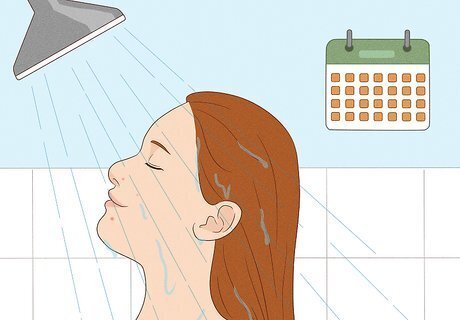
Shower or bathe every day. Get in the habit of washing your skin every day by taking a bath or a shower. If you sweat a lot, wash more frequently. If you don’t shower, at least rinse your skin after exercising. Excessive sweating can make blind pimples and other forms of acne worse, especially if you don’t rinse off right away. In general, keeping clean and moisturized is the best way to prevent blind pimples. Along with bathing regularly, wash your pillow cases, don’t touch your face with dirty hands, and never try to pop blind pimples.
Trying Herbal Home Remedies

Apply a warm compress. Since the blind pimple is deep under your skin, it takes longer for it to come to the surface and heal. To speed up the process, soak a cotton ball or cloth in hot water and apply it to the blind pimple for a few minutes. Do this up to three times a day until the blind pimple comes to a head. You can also soak a cotton ball in a hot herbal tea that contains peppermint, lavender, calendula, or thyme.

Soothe pain with an ice pack. If the blind pimple is causing your skin to feel red, inflamed, or painful, apply an ice pack for up to ten minutes. This can reduce swelling and make it easier to apply concealer. It also reduces the pain of a blind pimple. Always wrap an ice pack in a thin cloth. Avoid applying ice directly to your skin since this can damage your skin's delicate tissue.
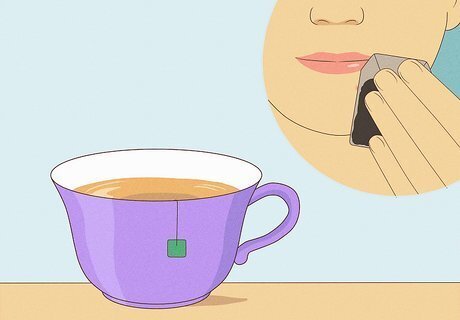
Use green tea. Use a lotion that contains 2% green tea extract to reduce your acne. Alternatively, soak green tea bags in warm water and apply them directly to the blind pimple for several minutes. The tea acts as an astringent which forces the pimple to reabsorb or come to the surface where antibacterial herbs can kill the bacteria. Studies show that green tea is useful in treating a variety of skin conditions.
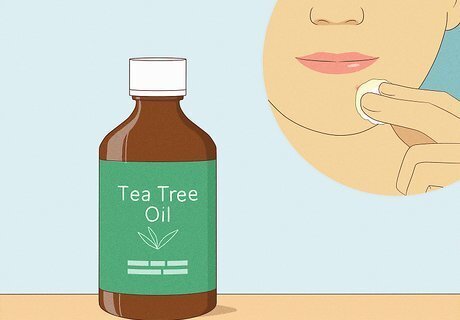
Dab tea tree oil on the pimple. Dip a cotton ball or cotton swab in undiluted tea tree oil. Apply the oil directly to your blind pimple. Don't rinse off the oil. The tea tree oil can reduce the inflammation that's causing your blind pimple, making it heal faster. Studies suggest that tea tree oil also has antimicrobial properties. More research is still needed to determine the extent of how effective topical tea tree oil applications are in treating bacterial or viral infections.

Make an herbal mask. Combine 1 tablespoon (14.8 mL) of raw honey, 1 egg white, and 1 teaspoon (5 mL) of lemon juice or witch hazel. Add ½ tsp (2.5 mL) of spearmint, lavender, or calendula essential oil and mix it all together. Spread the mixture over the area with blind pimples, then wash it off with lukewarm water after 15 minutes. Pat your skin dry to avoid pulling at your skin while removing the mask. Apply a non-comedogenic moisturizer after to lock in hydration. This mask can also be used as a spot treatment directly on blind pimples.














Comments
0 comment